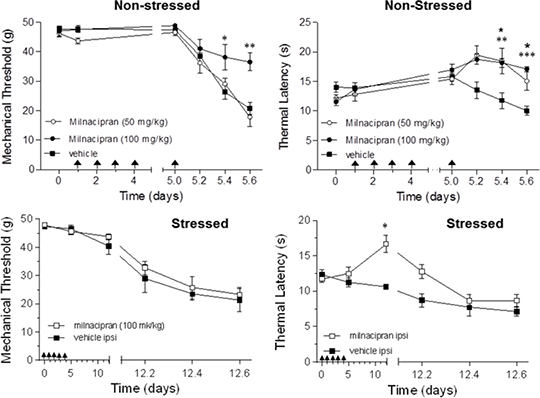The effects of the anti-depressant milnacipran on inflammatory and stress-induced hyperalgesia in rat Chronic pain has been associated with multiple disorders, of which depression and anxiety are among the top comorbidities in chronic pain populations. Stress is also a known precipitating factor in a number of chronic pain conditions. Growing evidence suggests that depression and pain share genetic factors as well as biological pathways and neurotransmitters, which has implications for treatment. The aim of this study was to investigate the therapeutic potential of the anti-depressant drug milnacipran to alleviate stress-induced hyperalgesia in a rat model of anxiety - the social-defeat model. The model used introduces an “intruder” rat (male Wistar rats; 305 ± 10 g; n=6) into a larger dominant rat’s homecage (male Han Wistar rats; 540 ± 44 g; n=6) for a short period of physical confrontation, followed by a longer period of protected confrontation. Stress-induced thermal and mechanical hyperalgesia were observed in intruder rats after 12 days of social-defeat conditioning, measured by increased sensitivity to thermal and mechanical hindpaw stimulation. Stressed rats also gained less weight compared to control animals, a recognised sign of stress, and displayed increased sensitivity to inflammatory pain induced by intradermal paw injection of the inflammatory agent carrageenan (1.5%; 50 μμl). The effects of oral administration for 5 consecutive days of the anti-depressant drug milnacipran (50, 100 mg/kg) or drug-vehicle on nociceptive responses were assessed in socially defeated stressed rats (n=6-8 per group). Milnacipran (100 mg/kg) attenuated mechanical and thermal stress-induced hyperalgesia (both p < 0.05 vs. vehicle), but had no effect on suppressed body weight gain. Administration of milnacipran was also found to inhibit carrageenan-induced inflammatory hyperalgesia (Fig. 1) in non-stressed rats but not in stressed rats (although thermal anti-nociception was observed in both inflamed and non-inflamed paws). 
Fig.1 Carrageenan-induced mechanical and thermal hyperalgesia in non-stressed and stressed rats (n=6-8/group), treated with 50, 100 mg/kg milnacipran or vehicle for 5 consecutive days (arrow). Attenuation of hypersensitivity: * P <0.05; ** p < 0.01 vs. vehicle. In conclusion, treatment with a conventional anti-depressant was effective in reversing inflammatory hyperalgesia in normal rats but not in animals exposed to chronic stress, demonstrating a divergence between pain sensitivity and clinic pain in the anxio-depressed subjects. |


